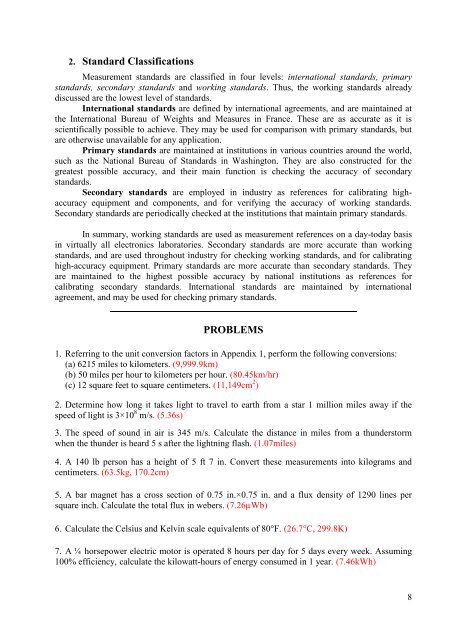Units, Dimensions, and Standards INTRODUCTION
Units, Dimensions, and Standards INTRODUCTION
Units, Dimensions, and Standards INTRODUCTION
You also want an ePaper? Increase the reach of your titles
YUMPU automatically turns print PDFs into web optimized ePapers that Google loves.
2. St<strong>and</strong>ard ClassificationsMeasurement st<strong>and</strong>ards are classified in four levels: international st<strong>and</strong>ards, primaryst<strong>and</strong>ards, secondary st<strong>and</strong>ards <strong>and</strong> working st<strong>and</strong>ards. Thus, the working st<strong>and</strong>ards alreadydiscussed are the lowest level of st<strong>and</strong>ards.International st<strong>and</strong>ards are defined by international agreements, <strong>and</strong> are maintained atthe International Bureau of Weights <strong>and</strong> Measures in France. These are as accurate as it isscientifically possible to achieve. They may be used for comparison with primary st<strong>and</strong>ards, butare otherwise unavailable for any application.Primary st<strong>and</strong>ards are maintained at institutions in various countries around the world,such as the National Bureau of St<strong>and</strong>ards in Washington. They are also constructed for thegreatest possible accuracy, <strong>and</strong> their main function is checking the accuracy of secondaryst<strong>and</strong>ards.Secondary st<strong>and</strong>ards are employed in industry as references for calibrating highaccuracyequipment <strong>and</strong> components, <strong>and</strong> for verifying the accuracy of working st<strong>and</strong>ards.Secondary st<strong>and</strong>ards are periodically checked at the institutions that maintain primary st<strong>and</strong>ards.In summary, working st<strong>and</strong>ards are used as measurement references on a day-today basisin virtually all electronics laboratories. Secondary st<strong>and</strong>ards are more accurate than workingst<strong>and</strong>ards, <strong>and</strong> are used throughout industry for checking working st<strong>and</strong>ards, <strong>and</strong> for calibratinghigh-accuracy equipment. Primary st<strong>and</strong>ards are more accurate than secondary st<strong>and</strong>ards. Theyare maintained to the highest possible accuracy by national institutions as references forcalibrating secondary st<strong>and</strong>ards. International st<strong>and</strong>ards are maintained by internationalagreement, <strong>and</strong> may be used for checking primary st<strong>and</strong>ards.PROBLEMS1. Referring to the unit conversion factors in Appendix 1, perform the following conversions:(a) 6215 miles to kilometers. (9,999.9km)(b) 50 miles per hour to kilometers per hour. (80.45km/hr)(c) 12 square feet to square centimeters. (11,149cm 2 )2. Determine how long it takes light to travel to earth from a star 1 million miles away if thespeed of light is 3×10 8 m/s. (5.36s)3. The speed of sound in air is 345 m/s. Calculate the distance in miles from a thunderstormwhen the thunder is heard 5 s after the lightning flash. (1.07miles)4. A 140 lb person has a height of 5 ft 7 in. Convert these measurements into kilograms <strong>and</strong>centimeters. (63.5kg, 170.2cm)5. A bar magnet has a cross section of 0.75 in.×0.75 in. <strong>and</strong> a flux density of 1290 lines persquare inch. Calculate the total flux in webers. (7.26µWb)6. Calculate the Celsius <strong>and</strong> Kelvin scale equivalents of 80°F. (26.7C, 299.8K)7. A ¼ horsepower electric motor is operated 8 hours per day for 5 days every week. Assuming100% efficiency, calculate the kilowatt-hours of energy consumed in 1 year. (7.46kWh)8
















